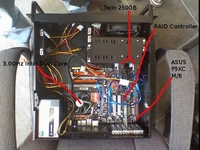Alright - it turns out the RocketRAID is both a snare and a delusion.
- The claims of hardware RAID are simply false - all processing is pawned off onto the system CPU.
- The 'open-source drivers' are actually open-source wrappers for closed-source drivers. In either event, they're impossible to slip stream during OS installation.
- Supports every major linux distro my ass.
So.....we've since purchased an LSI MegaRAID 150-6 RAID controller. I know for a fact this is a hardware RAID card. It also has a nifty little battery backup so it can finish writes in the event of a power failure. Since that battery can't possibly power the connected drives, I'm guessing that it just writes the data to on-board flash memory or something and completes the writes the next time the device is powered on. Regardless, it's a nice piece of equipment.
Now of course the OS install disk we're using is informing us that we don't have a valid CD drive attached. Keep in mind that this is coming from a program loaded off a CD. A problem for tomorrow.
On May 9th, I'm leaving the IS department at Rackspace. I like doing dev work on my own, but there is not the place to do it for me. I'm a single Ruby coder surrounded by Python guys and the end result is that I just have nothing to do. I'm looking for something internally, so we'll see how that goes.

